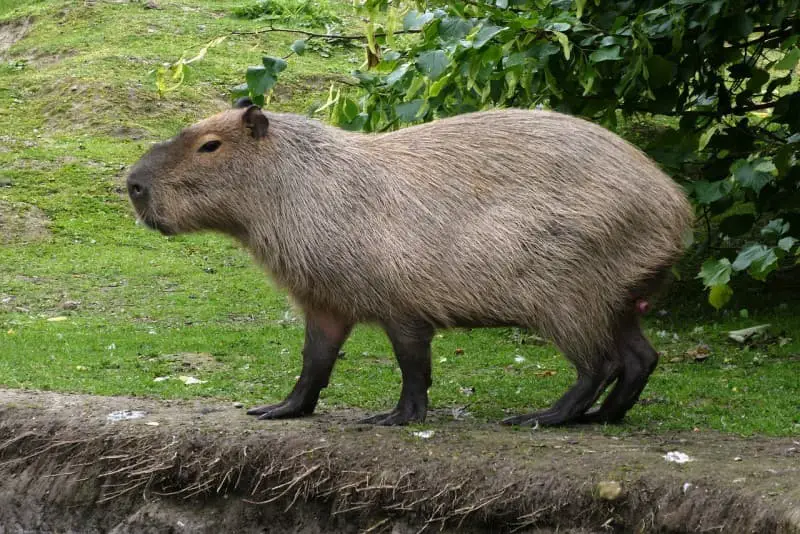Since hummingbirds are the tiniest birds on the planet, it should come as no surprise that their eggs are minuscule. In comparison to other species, how little are hummingbird eggs exactly? Hummingbirds in their nests are exactly fed by these fragile pearls of nature.
For those with limited time, the following is a brief response to your inquiry: The typical hummingbird egg is 0.5 inches length and 0.3 inches broad, roughly the size of a jellybean. It’s not even as big as a cent!
This in-depth post will examine hummingbird egg sizes in great detail. You’ll discover why it matters that they are so little as well as how their tiny size relates to the eggs of other birds. Additionally, we’ll look at how the female constructs a nest to hold these tiny eggs and how the youngster grows within its Lilliputian shell.
Normal Hummingbird Egg Dimensions
Hummingbirds are extraordinarily little creatures, matched in size only by their fragile eggs. Hummingbird eggs range in length from 0.5 to 0.8 inches on average, however the size of each species’ eggs might vary somewhat. They resemble little grapes or jellybeans in size.
These eggs are tiny, but they’re mighty because they have all the genetic material and nutrients needed to grow into mature hummingbirds.
Measurements of length and breadth
Typically oval in form, hummingbird eggs have a slightly sharper tip on one end than the other. The eggs are usually between 0.3 and 0.5 inches wide and between 0.5 and 0.8 inches long.
Because of their small size, the eggs may nest comfortably in the hummingbird’s nest, which is usually constructed from moss, plant fibers, and spider silk in a tree or shrub.
Comparing using coins
To put the size of hummingbird eggs into perspective, picture an egg that is about the length of a nickel or a quarter. The idea that a creature this little could lay such tiny eggs is astounding.
In fact, since hummingbird eggs are so fragile, you may need to take extra care not to crush them if you were to hold one in your hand.
Form and roughness of the surface
Hummingbird eggs are typically oval-shaped capsules or slightly larger than a little football. Because of their form, the eggs have more surface area, which promotes effective gas exchange throughout the incubation period.
In addition, the eggs’ smooth surface could make it simple for the mother hummingbird to flip and rearrange them while she perches on the nest to keep them warm.
Even though hummingbird eggs are little, it’s amazing to see the fine intricacies within. For the next generation of these amazing birds to evolve successfully, their special qualities are essential.
Comparing Hummingbird Eggs with Those of Other Species
As hummingbirds are renowned for being tiny and agile, so too are their eggs. These little birds produce some of the tiniest eggs in the whole bird world. Let’s examine the differences between hummingbird and other species’ eggs in more detail.
In relation to the range of bird egg sizes
There is significant variation in the size of bird eggs. Large birds such as ostriches and emus have eggs that may weigh several pounds, which is the same as many chicken eggs. These eggs are on the heavier end of the spectrum. On the other end are the tiny songbird and hummingbird eggs.
Hummingbird eggs are so tiny that people often miss them because of their small size.
larger ostrich and chicken eggs
Hummingbird eggs are quite little compared to those of chickens and ostriches, which have bigger eggs. A hummingbird egg weighs less than a gram and is less than an inch long, but a chicken egg may weigh up to 50 grams and measure over 2.5 inches in length.
Indeed, a single chicken egg may hold many hummingbird eggs!
Other little avian eggs, such as finches
Hummingbird eggs are notably tiny, even in comparison to other small bird species like finches. Finches lay bigger, but still relatively little, eggs than hummingbirds do. They are distinguished by their bright plumage and melodic songs.
Though species-specific variations exist, finch eggs are usually bigger than hummingbird eggs but smaller than chicken eggs.
The way that nature has been able to vary and adjust egg sizes to meet the requirements of various bird species is quite amazing. Each species has developed to secure the survival of their progeny in their own habitats, as seen by the size of ostrich eggs and hummingbird eggs.
The Reasons Behind Hummingbird Egg Sizes
Hummingbirds are among the tiniest birds in the world, although they are renowned for their amazing agility and quick wingbeats. Therefore, it should come as no surprise that their eggs are little. The following explanations explain why hummingbird eggs are so tiny:
Flight weight restrictions
Hummingbirds are experts at flying, having developed the ability to fly backwards and hover in midair. Their little stature does have some drawbacks, however. Hummingbirds cannot afford to be overweight in order to preserve their exceptional flying ability and agility.
Because of this, their eggs have evolved to be tiny and light, making it easy for the mother bird to carry them while flying.
Squeeze into little nests
Hummingbirds use lichens, spider silk, and plant fibers to construct elaborate nests. These nests are often found in safe places like the branches of trees or bushes. They are typically rather tiny, frequently resembling thimbles or cups.
The eggs’ modest size makes sure they fit snugly into these little nests, giving the mother bird enough room to incubate them while shielding them from the weather and predators.
Less eggs to hatch
Hummingbirds normally lay fewer eggs than other bird species, which contributes to the tiny size of hummingbird eggs. Hummingbirds typically only lay one or two eggs at a time, yet some birds have been known to lay twelve or more in a single clutch.
Hummingbirds may focus their efforts and resources on ensuring the survival of each individual child by producing fewer eggs. Because the eggs are tiny, the mother bird can provide them plenty of warmth and food while they are being incubated.
Constructing a Nest for Tiny Eggs
The extraordinarily tiny hummingbird eggs are typically around 0.5 inches long. These eggs are small, yet they need a well-built nest for protection and incubation. Let’s investigate how hummingbirds construct their nests to hold their tiny eggs.
Size and composition of the nest
Hummingbird nests, despite their small size, are engineering marvels. They usually have an average diameter of 1.5 inches, making them about the size of a golf ball. Plant fibers, spider webs, and lichens are among the materials used to build these nests.
The spider webs provide the nest strength and flexibility as they connect it together.
Hummingbirds often use the surrounding flora for support and camouflage as they construct their nests on tree branches or even clotheslines. The little eggs have a comfortable place to rest in the small, cup-shaped nests.
Defense against the weather
In addition to accommodating the size of the eggs, hummingbird nests are constructed to shield the eggs from the weather. The intricately woven framework protects the eggs from wind and rain. Soft plant fibers are often used for the nest’s exterior layer, which acts as insulation and keeps the eggs warm in colder months.
The placement of the nest is also very important for keeping the eggs safe. Hummingbirds deliberately choose areas with natural shelter, such thick vegetation or overhanging branches. By doing this, the eggs are shielded from the sun and any predators.
Hiding from potential attackers
Hummingbird eggs are susceptible to being eaten by squirrels, snakes, and other birds despite their tiny size. Hummingbirds conceal their nests well in order to reduce the chance of being eaten.
The nests’ ability to blend in with their surroundings is facilitated by the use of lichens and moss in their construction. These materials’ hues and textures imitate the look of mossy branches or tree bark, which makes it harder for predators to find the nests.
Hummingbirds also often choose nesting locations that provide natural cover and are well-hidden. This increases the likelihood that possible predators won’t find their nests.
The construction of a nest for little hummingbird eggs requires meticulous attention to detail. When it comes to protecting their young from the environment and predators, hummingbirds are remarkably adaptive and ingenious. Their nest size and materials are just a few examples.
Growing Inside an Egg the Size of a Teacup
Hummingbirds are little, fragile birds that are well-known for their vivid coloring and amazing flying ability. Their eggs are among the tiniest deposited by any bird species; they are scarcely bigger than a jellybean or coffee bean.
The secret to the next generation of these amazing animals lies in these teacup-sized eggs.
Egg white and yolk nutrients
Hummingbird eggs are tiny, yet they are packed full of all the nutrients needed for the developing baby. The essential proteins are found in the egg white, or albumen, whereas lipids and other nutrients are found in the yolk.
Even in such a little area, the hummingbird embryo has everything it needs to develop and survive because to its nutrient-rich composition.
Less growing spaces than other birds
Hummingbirds have particular difficulties because of the little amount of room in their eggs compared to other bird species. Hummingbird eggs are smaller than bigger bird eggs and so have less area for the embryo to grow, which makes the development process more difficult.
But because to adaptations provided by nature, these small animals can successfully hatch despite these challenges.
Hatching difficulties
The hummingbird embryo has additional difficulties once it is mature and prepared to hatch. Because of the tiny size of the eggs, the hatchlings need to be very small and nimble in order to crack through the shell.
Using their unique beaks, hummingbird chicks break through the eggshell and go out into the world.
Thinking about the trip these little hummingbird eggs take is quite wonderful. These eggs are modest in size, but they are packed with all the nutrients needed for the embryo to grow, and the hatchlings come with the means to escape their tiny shells.
Consider the amazing trip hummingbirds have taken, beginning with their teacup-sized eggs, the next time you see one in your yard.
Final Thoughts
Hummingbirds are a miracle of nature; their pea-sized eggs provide for the requirements of the tiniest bird species on the planet. Hummingbirds’ small size enables them to procreate effectively and keep entertaining us with their soaring feats.
These tiny eggs serve as a reminder that even the most remarkable structures seen in nature may be found in very little forms. Everything is there for the small hummingbird baby developing within to eventually hatch into the brilliant gem we all know and adore.






